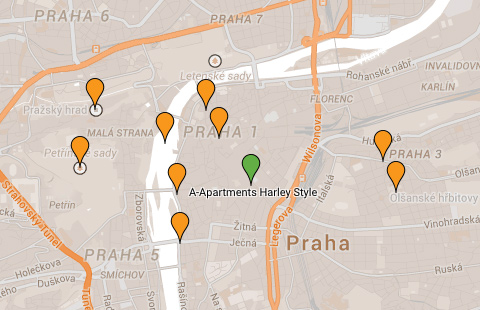Thanks to our unique location in the heart of Prague everything is close. Whatever you decide for the old Prague, Charles Bridge, Old Town Square, Prague Castle, the Jewish Quarter, Dancing House, National Theatre, Žižkov TV Tower, Petrin Tower, everything can be easily reached by foot. And if you do not want to bother walking, you can select public transport which is located just in front of our entrance.
Prague full of history

Prague Castle is most significant Czech castle (originally an early medieval settlement) standing above the Vltava river in center of Prague. Dating from the 9th century it has been a seat of power for kings of Bohemia, Holy Roman emperors and is the official residence and office of the President from year 1918.
Prague Castle is regarded not only as a symbol of the city, but also the Czech statehood. It occupies an area of almost 70,000 m2, at about 570 meters in length and an average of about 128 meters wide. The Guinness Book of Records lists Prague Castle as the largest ancient castle in the world.
The Bohemian Crown Jewels are kept within a hidden room inside it.
St. Vitus Cathedral is also part of Prague Castle. It is the traditional place of coronation of Czech kings. The cathedral houses tombs of many Bohemian kings and four Holy Roman Emperors. One of most important tomb belongs to St. Wenceslaus, who had by now become the patron saint of the Czech. Source CC-BY-SA
Prague castle
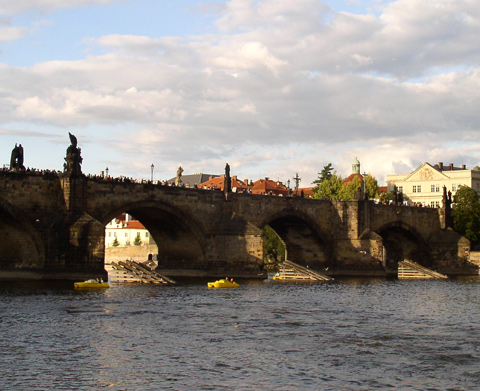
Charles Bridge is the oldest stone bridge still standing over the Vltava river in Prague and is the second oldest bridge in the Czech Republic.
The bridge replaced the old Judith Bridge that had been badly damaged by a flood in 1342. Charles Bridge construction started in 1357 under the auspices of King Charles IV, and finished in the beginning of the 15th century. Prague has become, thanks to this stone bridge a major stop on the European trade routes.
The bridge is decorated by a continuous alley of 30 statues and statuaries, most of them baroque-style, originally erected around 1700 but now all replaced by replicas. This new bridge was originally called the Stone Bridge or the Prague Bridge but has been called the Charles Bridge since 1870. Source CC-BY-SA
Charles bridge

Old Town Square (formerly the Great Square) is a square in the center of Prague's Old Town and the historic center of the city at all. It covers area of over 9,000 m². The royal road passes through here.
The Old Town Square is surrounded by remarkable historic buildings such as Old Town Hall with Astronomical Clock, Church of Mother of God before Týn, St. Nicholas Church in Old Town, Kinsky Palace, "Stone Bell House" and more.
The square's center is home to a statue of religious reformer Jan Hus, who for his beliefs was burned at the stake in Constance, this led to the Hussite Wars. Source CC-BY-SA
Old Town Square
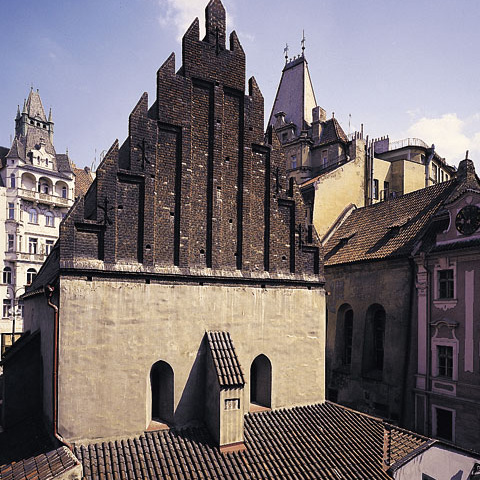
The Old New Synagogue is Europe's oldest active synagogue still used for religious ceremonies. It is also the oldest surviving medieval synagogue of twin-nave design.
Completed in 1270 in Gothic style, it was one of Prague's first Gothic buildings. The synagogue was originally called the New or Great Synagogue and later, when newer synagogues were built in the 16th century, it became known as the Old-New Synagogue.
To the creation the synagogue is also related creation of the Jewish cemetery Jewish Garden in the Prague's New Town. The synagogue is gradually becoming a center of the Jewish Quarter.
In the surrounding area there is an open space, which is used as a marketplace. This free space also fulfills function of fire protection, because if surrounding houses burns the flames can not jump to the synagogue. Source CC-BY-SA
Old New Synagogue

The Dancing House, or "Fred and Ginger", is the nickname given to the Nationale-Nederlanden building on the Rašínovo nábřeží.
Its name comes from its two corner towers, inspired by the famous interwar dance pair of Fred Astaire and Ginger Rogers. It was designed by the Croatian-Czech architect Vlado Milunić in cooperation with Canadian-American architect Frank Gehry on a vacant riverfront plot.
The very non-traditional design was controversial at the time because the house stands out among the Baroque, Gothic and Art Nouveau buildings for which Prague is famous. Source CC-BY-SA
Dancing house
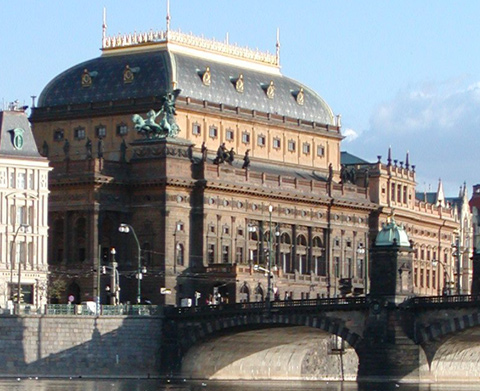
The National Theatre in Prague is known as the alma mater of Czech opera, and as the national monument of Czech history and art. The National Theatre belongs to the most important Czech cultural institutions, with a rich artistic tradition which was created and maintained by the most distinguished personalities in Czech society.
Construction started under the guidance of architect Josef Zítek on 16. 5. 1868 and theater was opened for the first time on 11 June 1881, to honor the visit of Crown Prince Rudolf of Austria.
The National Theatre is not only theater building itself, but has always been a symbol of Czech national revival. At the day when foundation stone was laid a national parade started attended by all significant Czech artists and politicians to celebrate completing public donations as the only funding for this building. Source CC-BY-SA
National theatre
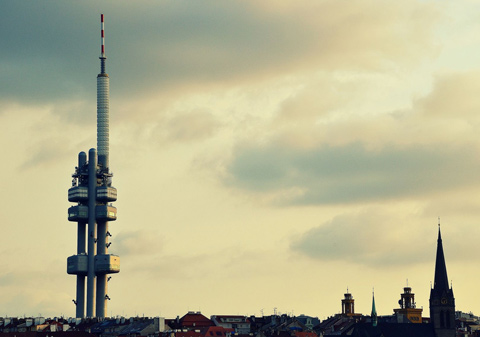
The Žižkov Television Tower is a unique transmitter tower built in Prague between 1985 and 1992. Designed by the architect Václav Aulický and the structural engineer Jiří Kozák. It stands high above the city's traditional skyline from its position on top of a hill in the district of Žižkov, from which it takes its name.
The tower is an example of high-tech architecture. In total, the tower stands 216 meters (709 feet) high. The structure of the tower is unconventional, based on a triangle whose corners are growing up in steel columns, consisting of three tubes with a double steel wall, filled with concrete. In its time it was a unique technology, which authors have patented. Source CC-BY-SA
Žižkov television tower
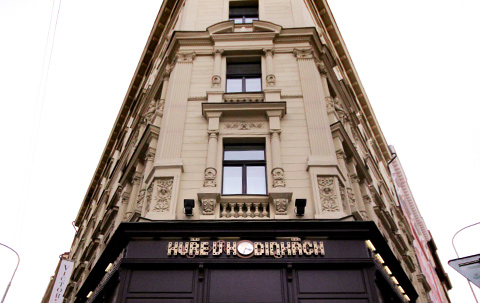
"Chicken in the Watch" is Legendary restaurant and music bar named after the eponymous rock album from year 1972 composed by Czech fusion band Flamengo led by singer Vladimir Mišík. Many listeners and critics have labeled this album as the best album that came out from Czech rock music scene. It is a unique space where prominent representatives of not only Czech rock music scene met together.
There is not only great food and drinks, but you can also listen to excellent live music, often in the unique composition of famous Czech bands and musicians.
Kuře v hodinkách
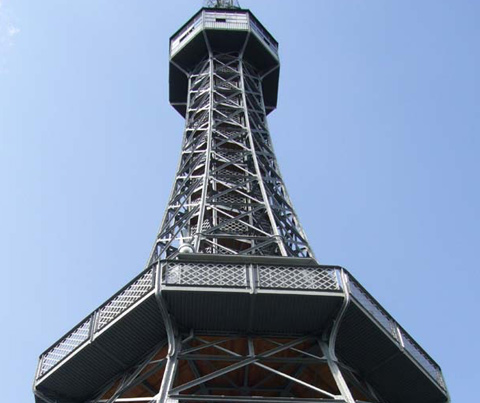
The Petřín Lookout Tower is a 63.5-metre-tall steel-framework tower in Prague, which strongly resembles the Eiffel Tower. Although it is much shorter than the Eiffel Tower, it stands atop a sizable hill, Petřín, so the top is at a higher elevation than that of the Eiffel Tower. In 1889, members of the Club of Czech Tourists visited the world exposition in Paris and were inspired by the Eiffel Tower. They collected a sufficient amount of money and in March 1891 the building of the tower started for the General Land Centennial Exhibition. Tower was designed by the architect Vratislav Pasovský and authors of construction were Ing. František Prášil a Ing. Julius Souček from of the Českomoravské strojírny. Tower was finished in only four months in 1891.
The Petřín Lookout Tower was used as an observation tower as well as a transmission tower. Source CC-BY-SA
Petřín Lookout Tower
Created by JMH © 2015 all rights reserved

